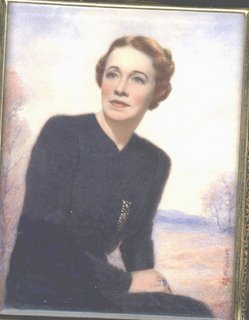
 These two miniatures were acquired together and are both believed to be portraits of the American actress Lillian Russell (1861-1922).
These two miniatures were acquired together and are both believed to be portraits of the American actress Lillian Russell (1861-1922).She became one of the most famous actresses and singers of the late 19th century and early 20th century, known for her beauty and style, as well as for her voice and stage presence.
Russell was born in Iowa but raised in Chicago. Her parents separated when she was eighteen, and she moved to New York with her mother. She quickly began to perform professionally, singing for Tony Pastor and playing roles in comic opera, including Gilbert and Sullivan works. She married composer Edward Solomon in 1884 and created roles in several of his operas in London, but in 1886 he was arrested for bigamy. Russell was married four times, but her longest relationship was with Diamond Jim Brady, who supported her extravagant lifestyle for four decades.
In 1885, Russell returned to New York and continued to star in operetta and musical theatre. For many years, she was the foremost singer of operettas in America, performing continuously through the end of the nineteenth century. In 1899, she joined the Weber and Fields's Music Hall, where she starred for five years. After 1904, she began to have vocal difficulties and switched to dramatic roles. She later returned to musical roles in vaudeville, however, finally retiring from performing around 1919. In later years, Russell wrote a newspaper column, advocated women's suffrage and was a popular lecturer.


Although the miniatures have no identifying inscription, a previous owner had purchased them as being of Lillian Russell. There are various known photographic portraits which are similar and thus support the identification. They include the examples showing here.
The miniature with the older sitter is less certainly of Lillian Russell, but their shared provenance, the apparent date of painting, a similar curl in the middle of her forehead, and the predilection towards the wearing of pearls all support an identification as Lillian Russell.
One of the two artists is unknown, but the other portrait is signed C S Wiltschek, for Charles Sigfried Wiltschek. He was an art dealer in New York, but he also painted many miniatures, usually over a faint photographic base, as was common in early 20C America. Other examples in this collection are:



Some collectors reject miniature portraits with photographic bases, but they are an important part of art history, bridging purely painted portraits and purely photographic portraits.
Hence, I believe miniatures painted over a photographic base are under-rated in terms of collectability, as they are part of the history of both branches. Early photographs of known sitters are sought after, even where there are multiple examples. Thus, painted portraits over a photographic base are even rarer. 1426, 1427